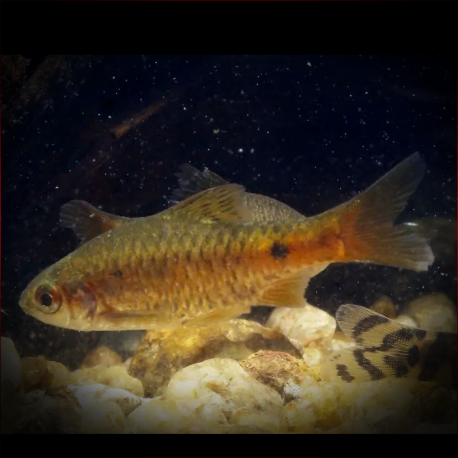More info
Datasheet
| Minimum Tank Size | 90 litres / 23.78 US gallons |
| Maximum Size | 4.2cm / 1.65inches |
| Temperature | 20°C / 68.00°F - 25°C / 77.00°F |
| Hardness | 2.02dgH / 36ppm - 15.02dgH / 268ppm |
| pH | 5.5-7.5 |
General Description
The Pookode Lake Barb, scientifically known as Pethia pookodensis, is a small, peaceful species that is not commonly found in the aquarium trade outside of India. It belongs to the family Cyprinidae and reaches a maximum size of about 4.2cm. The species is classified under the order Cypriniformes and is part of the genus Pethia.
Aquarium Setup
For optimal care of the Pookode Lake Barb, a tank size of at least 90 litres is recommended. The species prefers a well-planted aquarium with a dark substrate to enhance its coloration. Addition of floating plants, driftwood, branches, and leaf litter is appreciated. The barb does not require strong filtration but benefits from some water movement, thriving in a hill stream-type setup. Water conditions should be maintained at a pH range of 5.5-7.5, with a temperature between 20-25°C and a hardness of 36-268ppm (see table).
Behaviour
Known for its peaceful nature, the Pookode Lake Barb is an excellent choice for community aquariums. It is a schooling species that should be kept in groups of 6-10 individuals to reduce skittish behavior and enhance natural displays. In the presence of conspecific rivals, males will display more vibrant colors.
Feeding and Diet
In the wild, these fish are foragers, consuming diatoms, algae, detritus, insects, worms, and zooplankton. In captivity, they readily accept small live and frozen foods like bloodworms, Daphnia, and Artemia, along with high-quality dried flakes and granules containing plant or algal content.
Reproduction & Dimorphism
Reproduction behavior of the Pookode Lake Barb remains unrecorded. Adult males exhibit more vibrant colors and are smaller and slimmer compared to females. During the spawning season, males display orange pigmentation in the posterior body region.
Habitat and Distribution
Native to Pookode Lake in the Wayanad district of Kerala state in southern India, the species may be endemic to this region, with unconfirmed sightings in the surrounding Wayanad Wildlife Sanctuary. The lake is a freshwater body surrounded by forests, known for its boating activities and is a popular tourist destination. Due to habitat degradation, the IUCN classifies Pethia pookodensis as "Critically Endangered" on their Red List.

